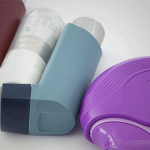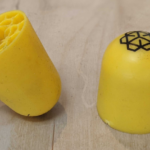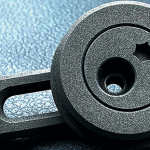- Home
- 3D Printing
- Seven limitations of SLS
Seven limitations of SLS
Selective Laser Sintering (SLS) is one of the most popular 3D printing technologies, both for prototyping and end-use applications. Nevertheless, no single technology is ideal for every part, so in this article, we will explore seven limitations of SLS.
1. We only build parts with one grade of material
Because of the very fine nature of SLS powder, we have segregated areas within our 3D printing department specifically for making and cleaning SLS parts. Operating with more than one material necessitates procedures and precautions to avoid cross-contamination.
Implementing these would add cost and complexity to the 3D printing process, as well as extending lead times when changing over from one material to another. Consequently, we have taken the decision to use one material only.
We 3D print SLS parts in EOS PA 2200 Nylon material (base PA12). This grade enables us to build good quality parts with a surface finish and accuracy that suits our customers’ needs for SLS parts. Finished parts have high stiffness and strength, as well as good long-term stability and abrasion resistance. These characteristics result from a combination of the material properties of PA 2200 and the good powder fusion. In addition, PA 2200 is chemical-resistant, biocompatible according to EN ISO 10993-1 and USP Class VI (121 °C) and is approved for food contact. Please request regulatory information if required.
In the vast majority of projects for which customers request SLS, the material properties meet or exceed the requirements. However, if the material is unsuitable, we can 3D print in other materials but this requires the use of another 3D printing technology. With four other processes in-house (SLA, DLP, PolyJet and PµSL), we can usually agree a technology and material with the customer. Alternatively, it is sometimes better if we CNC machine the part from a solid block of a more suitable plastic.
2. As-built parts are only available in white
As stated above, we only use PA 2200 for 3D printing SLS parts and that material is white. Consequently, self-coloured parts are only available in white.
For many prototyping applications the colour is irrelevant, but customers often require parts in another colour. We have facilities in-house for SLS dyeing, black is run most days, other colours are purchased to order. When SLS parts are dyed, the colour penetrates to a depth of approximately 0.5mm. If a dyed part is scratched, modified or suffers wear during use, the white base colour can become visible – though the same is true for any part that has been finished by wet painting or powder coating.
3. Small tapped holes are relatively weak
SLS parts are laser-sintered from powder, so the material properties will never be as good as those of a solid material. One way in which a reduction in strength can be problematic is with small tapped holes. To be fair, small tapped holes tend not to be particularly strong in most engineering plastics, including solid polyamide.
If tapped holes are necessary in SLS parts, it is sometimes possible to use larger fasteners or, more often, metallic threaded inserts. This second option is particularly beneficial if an assembly needs to be dismantled and reassembled multiple times, as metallic threaded inserts are far more resilient. Typically, we install either Helicoils or threaded brass inserts.
4. SLS 3D printed parts cannot have small internal passageways
One of the advantages of 3D printing compared with injection moulding is that complex internal passageways can be incorporated for flows of gases or liquids, or simply to save weight. With SLS, however, you have to bear in mind that the built part will be surrounded by partially-fused powder, and internal voids also contain partially-fused powder. This powder has to be cleaned from the part before it can be used. Unfortunately, the partially-fused powder often needs some ‘encouragement’ during the cleaning process, which might take the form of brushing, jets of compressed air, vibratory cleaning and small implements such as pipe cleaners and can be time-consuming.
Internal passageways can be particularly difficult to clean, so they need to be of a size that a pipe cleaner can be passed through, and it is best to avoid sharp corners in passageways. If a passageway is straight and accessible, 1mm diameter is usually the minimum, but cleaning is more difficult if passageways are curved or have corners.
Our experienced operatives can look at a 3D CAD model and say whether or not they think passageways can be cleaned. If there is any doubt, the issue will be discussed with the part designer so as to find a mutually acceptable solution.
One approach might be to switch from SLS to SLA, DLP or PµSL. These 3D printing technologies, all of which we have in-house, build parts from liquid photopolymers, and it can be far easier to clean uncured liquid from passageways than it is to remove partially fused powder from SLS parts.
5. Maximum build size is limited for SLS 3D printed parts
We have three EOS P1 SLS 3D printing machines, each of which has a build envelope of 220 x 250 x 330 mm. This is adequate for the vast majority of our customers’ SLS requirements but there are occasions when larger parts need to be made. Of course, there are size limitations with almost every manufacturing technology due to equipment availability, including other 3D printing technologies, CNC machining, vacuum casting, injection moulding and so on.
When it comes to 3D printing, including SLS, we can overcome size limitations by splitting the CAD model and 3D printing the part into two or more sections. These are subsequently joined by means of tongue-and-groove joints, adhesives, threaded fasteners or whatever is the most appropriate means for the part geometry and application.
6. SLS parts are not fully representative of injection moulded parts
The main way in which SLS parts do not represent injection moulded parts is the surface finish. This may or may not be important, depending on whether the part is required for functional testing, a visual model, or an end-use application. Nevertheless, SLS parts have good mechanical properties, so their characteristics such as robustness and longevity are usually similar to those of injection moulded parts.
SLS and injection moulding are very different manufacturing technologies. Residual stresses can be present in parts made using both technologies, so the parts might warp or distort at elevated temperatures if the geometry is unfavourable. Because SLS and moulded parts have different residual stresses, the movement in an SLS part is unlikely to be representative of the movement in a moulded part with identical geometry.
7. There is a trade-off between mechanical properties and mass
A key advantage of SLS compared with injection moulding is that complex geometries can be 3D printed that would be impossible to mould. Examples include lattice structures and internal voids. A solid part will be stiffer and stronger than one that comprises a lattice structure or has been hollowed out. Consequently, there is a trade-off between a part’s mechanical properties and its mass.
If need be, we can support designers with the optimisation of part geometries. In particular, we can advise on minimum cross-sections for lattice struts, minimum wall thicknesses for hollow parts, the need for escape holes, features to prevent or minimise distortion, and so on.
Talk to us
If you want to discuss SLS 3D printing or find out whether an alternative 3D printing technology might be better for your parts, speak to one of our experts on 01763 249760 or complete the enquiry form below to request a quote.





